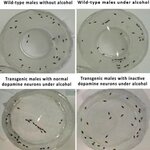Aging

A team of researchers at Penn Sate has used an animal model to reveal, for the first time, a physiological basis for the effect of alcohol on male sexual behavior, including increased sexual arousal and decreased sexual inhibition.
The research in PLoS ONE resulted in four novel findings with broad importance for further addiction research. It is the first study to characterize the effects of chronic alcohol exposure in fruit flies. "Physiological evidence supporting various theories about the effect of alcoholic drinks has been lacking, so our now having a suitable animal model makes it…

It's good news that we are living longer, but bad news that the longer we live, the better our odds of developing late-onset Alzheimer's disease.
Alzheimer's is a debilitating neurodegenerative disease that causes memory loss, dementia, personality change and ultimately death. The national Alzheimer's Association estimates that 5.1 million Americans are currently afflicted with the disease and predicts that the number may increase to between 11 million and 16 million people by the year 2050.
Many Alzheimer's researchers have long touted fish oil, by pill or diet, as an accessible and…

The melodious sound of a songbird may appear effortless, but his elocutions are actually the result of rigorous training undergone in youth and maintained throughout adulthood. His tune has virtually “crystallized” by maturity. The same control is seen in the motor performance of top athletes and musicians. Yet, subtle variations in highly practiced skills persist in both songbirds and humans. Now, scientists think they know why.
Their finding, reported in the current issue of “Nature,” suggests that natural variation is a built-in mechanism designed to allow the nervous system to explore…
Did you know even bacteria get old? Scientists traditionally assumed that bacteria were immortal, since these single-celled organisms split into two apparently identical daughter cells, which in turn divide, and so on. We now believe that this is not true.
Eric Stewart of Northeastern University, and his colleagues took fluorescent images of individual E. coli cells over ten generations. Each generation the E. coli cells divide down the middle, giving each daughter cell one new tip and an old tip from its mother, or grandmother, or some older ancestor.
Photo From: Aging and Death in E. coli…

MINNEAPOLIS, December 19 /PRNewswire/ --
Nonin Medical, Inc., a leading innovator of physiological monitoring solutions, received the 2007 Industry Best Practices Award for Product Differentiation Innovation from Frost & Sullivan. Frost & Sullivan recognizes outstanding industry achievements and the Awards are recognized worldwide by the media, the investment community and end-user markets. The global growth consulting company honored Nonin for its pioneering vision that has transformed the vital sign monitoring industry and brought powerful, portable and easy-to-use pulse oximetry…

No human can survive longer than a few minutes underwater, and even a well-trained Olympic swimmer needs frequent gulps of air. Our brains need a constant supply of oxygen, particularly during exercise.
Contrast that with Weddell seals, animals that dive and hunt under the Antarctic sea ice. They hold their breath for as long as 90 minutes, and remain active and mentally alert the whole time. The seals aren't fazed at all by low levels of oxygen that would cause humans to black out. What's their secret?
Certain animals--including dolphins, whales and sea otters--appear to be protected by…

Long-lived, wild animals harbor genetic differences that influence how quickly they begin to show their age, according to the results of a long-term study reported in Current Biology. Evidence for the existence of such genetic variation for aging rates—a central tenet in the evolutionary theory that explains why animals would show physiological declines as they grow older—had largely been lacking in natural populations until now, the researchers said.
“We’ve found that individuals differ in their rates of aging, or senescence, and that these differences are (at least in part) caused by…

LEUVEN, Belgium, December 11 /PRNewswire/ --
- TB-402 Shows Clear Promise as a Stable Long-acting Anticoagulant for the Prevention of Thromboembolic Disorders.
ThromboGenics NV (Euronext Brussels:THR), a biotechnology company focused on vascular and eye disease, announced that the results of the first Phase I trial of TB-402 were presented yesterday at the prestigious American Society of Hematology (ASH) 49th Annual Meeting in Atlanta, Georgia, USA. TB-402 is being co-developed in collaboration with BioInvent International (Nordic Exchange: BINV).
TB-402 is a recombinant human…

Research has shown convincing evidence that dietary patterns practiced during adulthood are important contributors to age-related cognitive decline and dementia risk. An article published in Annals of the New York Academy of Sciences highlights information on the benefits of diets high in fruit, vegetables, cereals and fish and low in saturated fats in reducing dementia risk.
Adults with diabetes are especially sensitive to the foods they eat with respect to cognitive function. Specifically, an adult with diabetes will experience a decline in memory function after a meal, especially if…

An age-related decline in heart function is a risk factor for heart disease in the elderly. While many factors contribute to a progressive age-related decline in heart function, alterations in the types of fuels the heart uses to produce energy also play important roles.
Jason Dyck and his research team at the University of Alberta have been studying the types of fuels used by the heart in young and aged mice. The young healthy heart normally used a balance of fat and sugar to generate energy to allow the heart to beat and pump blood efficiently. However, as the heart ages the ability to use…